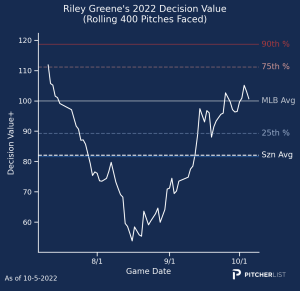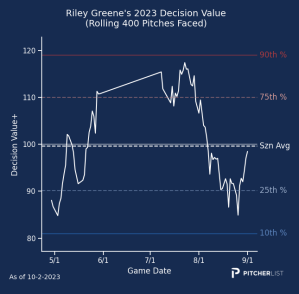Whether you play dynasty or redraft, the expectation that top prospects will blaze through the minor league system is always very high, and maybe it’s just recency bias, but it seems that way now more than ever. One of the things I like to preach as a fantasy strategy (which sort of ties into player evaluations and expectations) is to avoid strict guidelines.
What I mean by that is that we naturally will always gravitate towards certain tendencies when it comes to team building and whatnot, and a big part of the effort is in not constraining yourself to one way of thinking, even if it goes against what you normally do. This is just a fancy way of saying we can and should roster anyone in the right context, and play in enough leagues, and you’ll find that context.
A perfect example of this situation is the man among boys in the Tigers lineup, Riley Greene. If you invested in his rookie season and were dissatisfied, there was enough to make you want to come back a second time. If you invested in him last season and still felt a bit underwhelmed, you might have still gotten back in for 2024. We’re not talking about the sunk cost fallacy, but there is a good chance the price you paid for Greene in 2024 was reasonable enough to make it an enticing possibility.
Back to strategies and whatnot; usually in dynasty, I’ll steer clear of trendy top prospects because the market almost never offers a reasonable price, and even among the very best, what you’re getting isn’t a lock. In fact, it can be rather volatile. Gunnar Henderson worried us in the first half of last season. Corbin Carroll has us worried since the shoulder injury. Jordan Walker and Spencer Torkelson, we’re all still waiting on. And I don’t mean to speak of this as a rule to follow—it’s just a tendency of mine.
Usually, although there are exceptions with this level of talent, these guys figure it out, it’s just not always a linear process, and that’s where Riley Greene comes in and why the beginning of the season was a great time to buy in on him. Interestingly enough, if you look for linear growth, Greene presents that rather well, it’s just not necessarily something that you can always bank on with everyone. Greene has taken steps forward from his rookie year to his sophomore season and now his third campaign. Sure, in terms of just general production, Greene has evolved somewhat linearly, but how he has done that it’s not necessarily a common thing to expect, which is adding new elements to his game both in power and plate discipline.
As of June 18th, only the two studs in Houston (Kyle Tucker and Yordan Alvarez) and New York (Aaron Judge and Juan Soto) have a better wRC+ among outfielders than Greene’s 137 mark in 2024.
Back when he came up, Greene was ranked as the 2nd best prospect in baseball, trailing only Adley Rutschman, so to say expectations were high is an understatement. Although he took major steps forward in 2023, his first two years delivered question marks about his ability to get to real power in the bigs, boasting a .134 ISO before 2024.
Greene had been hitting the ball hard even last season, coming in with an average exit velocity of 91.6, but his flyball percentage was disappointing in the low 20s. Greene isn’t exactly Isaac Paredes these days, but he has drastically improved his FB% with a 30.1 mark, and he’s doing so with an outrageous 96.2 MPH exit velocity on those fly balls—he’s doing all sorts of damage.
Here is a glimpse into how unreal Greene’s damage on fly balls is: only five hitters in baseball have a higher SLG on fly balls than Greene’s 1.219. They are Aaron Judge, Gunnar Henderson, Juan Soto, Marcell Ozuna, and Tyler O’Neill.
Greene had already been doing damage on fly balls before, but he just wasn’t hitting enough of them to maximize their impact in his final line. There’s still room to grow, but 2024 is a major step.
Lauded for his incredibly advanced approach at the plate, Greene has held pretty significant strikeout rates since coming up, well above the MLB average. In a vacuum, that doesn’t stop you from achieving success, but if you’re going to run a strikeout rate of around 26-28%, you also need to walk a lot. Greene didn’t necessarily do that in his first two years, sitting at or right around league average.
Along with getting the ball in the air more often, Greene’s plate discipline has been the other major factor in helping him unlock his potential, as the lefty slugger currently has a 12.5% walk rate.
Here is a look at the evolution of his swing decisions in each year.



Greene could be more valuable if he ran, but we’ve seen more than enough to be sure that’s not happening, even though strictly discussing speed, he is faster than Kyle Tucker. Even though Greene has done well whenever he’s run, successful in all 10 attempts over the last two seasons, the Tigers as an organization don’t like to run a lot, currently last in the AL in stolen bases.
As far as batting average, probably the one aspect in which a Greene manager may not be entirely satisfied given he is hitting .254, as we’ve seen in the past, there is room for a superior number. However, even though his hit tool was very well-rated coming up, the contact ability in the majors doesn’t rate terribly well as one might have originally expected.
The best path for sustainable solid production is to work a high walk rate and get to as much power as possible by driving the ball in the air, as he’s proven he can do.
Going back to before this season started, Greene still had some believers, and you can see that in his ADP, but an investment in him didn’t carry the risk of other times. If you look for ways in which a hitter can be more successful with certain changes, you will find plenty of cases to corroborate the argument of a certain pick, and a lot won’t work out. Greene was coming into his third season, and he is now doing something different. The point is that where he went in most drafts, it still probably remained a healthy investment given his prospect profile and all that you could use to justify that selection.

